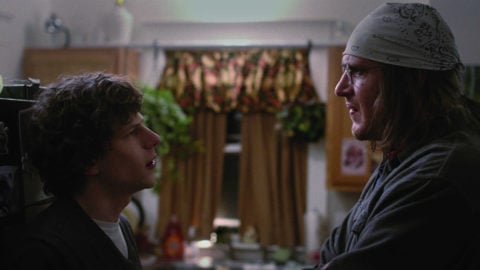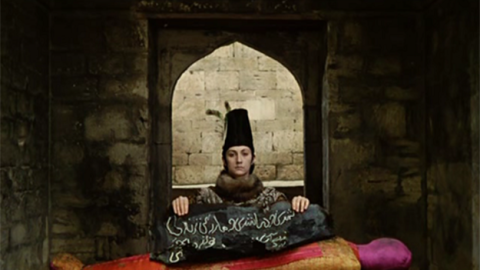Deep Focus: The End of the Tour
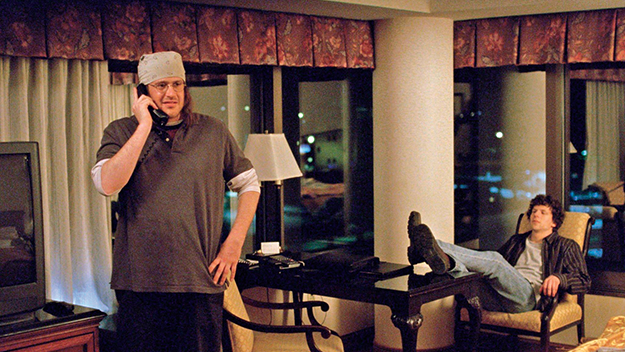
James Ponsoldt’s The End of the Tour is the rare literary film that feels spontaneous and packs a wallop. It’s full of wordplay—emphasis on both syllables. What Ponsoldt does with it goes beyond witty to potent and affecting. Donald Margulies’ beautifully rhythmic script centers on five days of interviews in March 1996 with David Foster Wallace (Jason Segel), the novelist who was then becoming famous as the exemplar of post-post-modernism. Admirers saw him as the spokesman for a narcissistic generation grown sick of its own self-absorption. The film pivots on a smart, envious fan and intellectual sparring partner, David Lipsky (Jesse Eisenberg), a Rolling Stone reporter who travels from New York to Bloomington, Illinois to talk to Wallace and watch him teach, then jets to Minneapolis with him on the last stop of his Infinite Jest tour. The source is Lipsky’s terrific 2010 interview book, Although of Course You End Up Becoming Yourself: A Road Trip With David Foster Wallace. Margulies sticks closely, not slavishly, to the actual words; for this review I quote the original text.
In his uniform of bandanna, flannel shirt, and work boots, Segel’s Wallace is the movie’s funky center of gravity. Eccentric and unassuming, anti-pretentious and brilliant, he’s a figure of endless fascination—especially as refracted through the shifting gaze of Eisenberg’s jittery Lipsky. Wallace must persuade this professional journalist that his uncorrupted, regular-guy persona is not merely a disarming construct or a put-on: it’s also an expression of his essential self.
Margulies told The Los Angeles Times’ Steve Zeitchik: “It’s all in the subtext. Lipsky’s agenda, the competitiveness, Wallace about to hit the stratosphere, the ticking clock of a young reporter going back to New York—it’s all there.” Margulies undersells himself. He doesn’t simply mine moral implications and psychological nuances from Lipsky’s transcripts. He rearranges whole blocks of dialogue to establish themes and turn subtext into text. He builds on Lipsky’s contradictory impulses to be more like Wallace and to expose him as “faux”—and on Wallace’s conflict between leveling with a fellow writer and resisting that writer’s mission to turn “David Foster Wallace” into a mass cultural property. Ponsoldt directs to match, bringing out the comedy in each man’s self-consciousness. Wallace admits that he’s just as “terrified” as Lipsky, but unlike the reporter, he stays “in the moment,” like an omniscient narrator of his own life. Ponsoldt wires his camera to their nerve endings and then, with a slight change of angle, depicts them with bracing objectivity. The End of the Tour testifies to Wallace’s toughness as well as his innocence and empathy. He sees through Lipsky’s provocative tactics and calls the reporter out on them. Wallace believes, in his core, that it’s a profound gift for a novel to alleviate another person’s loneliness. He refuses to “look across the room and automatically assume that someone is less aware than me, or that somehow their interior life is less rich, and complicated, and acutely perceived than mine.”
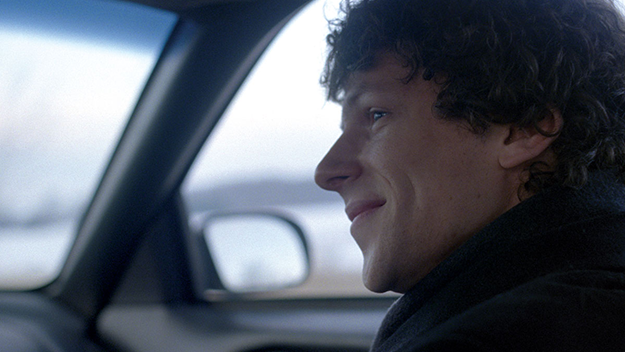
Segel and Eisenberg are funny, heartbreaking, intuitive—in a word, stunning. But this film is a quiet triumph for its entire ensemble, including Joan Cusack as an exuberant, clueless tour escort, Mamie Gummer as Wallace’s bubbly alt-weekly editor friend, and Mickey Sumner as an opaque poet ex-girlfriend. (Even the sloppy mixed-Lab dogs who play Wallace’s pets, Drone and Jeeves, are good.) Ponsoldt proved in Smashed (12) and The Spectacular Now (13) that he’s an actors’ director not merely because he nurtures his performers, but also because he uses his lens to bring viewers inside his characters’ minds. Because of Ponsoldt’s eye and ear, Wallace’s shot-from-the-heart declarations hit the theatrical bull’s-eye.
Like J.D. Salinger, Wallace could be simultaneously trenchant and amusing when evoking depression, his own terminal affliction. As he wrote in his first published story, “The Planet Trillaphon As It Stands in Relation to the Bad Thing” (a piece heavily influenced by Salinger): “You have to take your antidepressants at night, and you better make sure there is a bed nearby, because it will be bedtime incredibly soon after you take them.” He was the kind of writer Salinger’s Holden Caulfield was talking about when he said: “What really knocks me out is a book that, when you’re all done reading it, you wish the author that wrote it was a terrific friend of yours and you could call him up on the phone whenever you felt like it.” In The End of the Tour, Wallace has that effect on Lipsky, who is able to complete Holden’s fantasy. Lipsky, then 30, and Wallace, then 34, the ages of Segel and Eisenberg when they played these parts, achieve a brief fraternal bonding. They do it despite the editorial pressure on Lipsky to get what Rolling Stone thinks is the real story—anything to do with heroin addiction. (Wallace maintains that his main addiction is to television. He says that as a man who spends his life in libraries, he’s too squeamish to stick a needle in his arm.) Wallace is impassioned on the subject of being vulnerable to instant pleasures because he knows how susceptible he is to them himself. He doesn’t own a TV, so when his Minneapolis hotel room has cable, he gorges on reruns of Falcon Crest, Magnum P.I., and Charlie’s Angels. More important, we come to see that the outline Rolling Stone expects Lipsky to flesh out—a portrait of Wallace as a hip American success story—would go down just as easily, and be just as much a soulless fabrication, as any processed food or packaged entertainment.
The movie starts in 2008, as Lipsky responds to the news that Wallace has committed suicide. He appears on an NPR show to eulogize Wallace for cutting through the narcotizing texture of Americans’ media-saturated lives and offering them the brain-clearing experience “of being David Foster Wallace.” Using his quaint mini-cassette tapes as a time machine, the movie jumps back a dozen years. A talented fiction-writer as well as journalist, Lipsky had just published his autobiographical novel, The Art Fair. Wallace had just brought forth Infinite Jest, the mammoth, fiendishly inventive work that encompassed the jumble of late-20th-century life and demonstrated how an antic and beautiful mind could sift it for melancholy and absurdist gold.
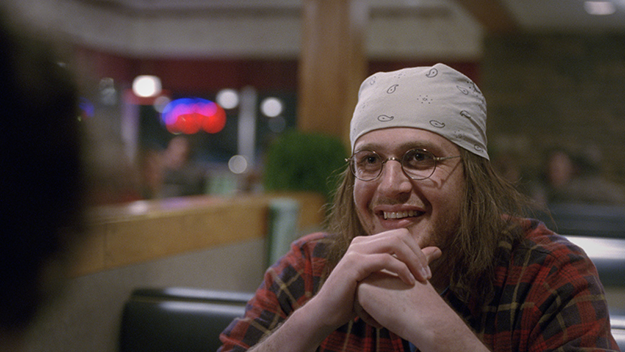
Ponsoldt and Margulies shape the material into a sophisticated tale of two Americas—New York, the center of the country’s cultural bureaucracy, and the rest of the United States, where it’s still possible (at least in 1996) for an independent artist like Wallace to stake out a fresh take on an increasingly franchised and digitalized world. Wallace feels that in New York he always hears “the enormous hiss of egos at various stages of inflation and deflation.” The End of the Tour presents Lipsky as a citizen of that New York. The feature-length flashback begins as Lipsky delivers key lines from The Art Fair for a small book-signing audience: “I didn’t understand SoHo . . . It wasn’t Upper East Side, and it was dirty. I felt marooned—our mother had taken us off the track of the nice life we’d been on.” Whether at a bookstore or a hip bar, Lipsky moves easily among the city’s up-and-coming or would-be literati. He knows just the right shrug to give when an acquaintance apologizes for passing up his event. He’s locked up a staff job at Rolling Stone, and his feelers are quivering for cultural emanations—what A Hard Day’s Night called “an early clue to the next direction.” So when Walter Kirn raves about Infinite Jest in New York Magazine—“Next year’s book awards have already been decided”—his curiosity and disbelief are palpable. His girlfriend (Anna Chlumsky) asks him to consider whether the book might actually be that good.
Margulies’ script extracts infectious existential comedy from Lipsky’s instant inferiority complex. Even before he convinces his Rolling Stone editors that he should profile Wallace for the magazine, he feels as if he’s in Wallace’s shadow. Without underlining anything, the movie gets across how galling it must be for Lipsky to see Wallace, a Midwestern soul who hasn’t fought for a niche in Brooklyn or Manhattan, assume his literary hegemony without any visible networking. Wallace is for Lipsky both an idealistic cause and an irritant. He argues with his editor that there hasn’t been a writer on the cover of Rolling Stone for 10 years. (Who was the last one? Hunter S. Thompson? John Irving?) Winning the argument, partly because a Time photo of Wallace in his usual bandanna makes him seem like a Rolling Stone kind of guy, Lipsky preps for his trip, taking a copy of The Art Fair to hand Wallace. Once he gets there he’s determined to portray Wallace not just as an original and substantial artist, but also as the most talked-about American writer on the scene.
Even if you haven’t read D.T. Max’s lyrically rounded biography of Wallace, Every Love Story Is a Ghost Story, you guess how cagy he’s being with Lipsky about substance abuse and recovery programs. You sympathize with his need for privacy and integrity. He’s determined to articulate the anguish that feeds addiction, not to serve up an educational cartoon of woe or an intriguing expressionist portrait of an artist. Lipsky prods Wallace this way and that, satisfying both his writer’s curiosity and his need to know what it’s like to be a roaring success. He elicits a self-portrait of a man who is genuinely at odds with acclaim and himself. Wallace’s themes of loneliness, addiction, distraction, and hollowness resonate through his life as well as his work. The movie peaks with Wallace’s final-act description of a breakdown he had in his twenties. He asks Lipsky to imagine a time when everything you believed about your life turned out to be false, “all a delusion. And that you were better than everyone else because you saw that it was a delusion, and yet you were worse because you couldn’t function.” For all of Wallace’s verbal pyrotechnics, nothing is more moving than this passage of plain speaking.
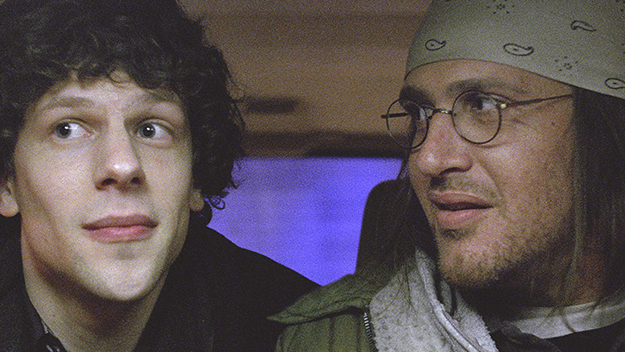
Ponsoldt’s mastery of fresh, unpredictable two-shots, and his ability to stage arguments that transcend verbal ping-pong, enable audiences to experience Wallace and Lipsky’s ups and downs without hyping. This skill is crucial for a movie that choreographs a pop-rock gavotte between an au courant reporter and a reluctantly chic novelist for three-quarters of the running time. It’s as if everyone, audience included, shares the same room temperature. Wallace grows comfortable with Lipsky partly because he can be frank without fear of judgment or misunderstanding, whether he’s discussing TV-watching and media-surfing as addictions and alternatives to the hard work of getting to know real people, or bewailing Americans’ willingness to cede whole parts of their consciousness and social life to unknown puppeteers. “It’s gonna get easier and easier,” he says, “and more and more convenient, and more and more pleasurable, to be alone with images on a screen, given to us by people who do not love us but want our money. Which is all right in low doses, right? But if that’s the basic main staple of your diet, you’re going to die. In a meaningful way, you’re going to die.” In Ponsoldt’s hands those ideas become concrete. For example, that sermon about high-caloric, non-nutritious visual entertainment erupts organically and hilariously when the two novelists are scarfing down junk food.
As Wallace, Segel pulls off a performance that’s like a transmigration of souls. He even chews tobacco like a natural. He conveys Wallace’s complex, tragicomic temperament with little more than a glinting half-smile or a semi-grimace. He can summon an artless, life-or-death urgency that’s devastating. And he also has a lively deadpan. His default expression is benevolent, mildly amused neutrality. He doesn’t push his cleverness. In Minneapolis, an NPR intern mentions that a show will be recorded digitally. She doesn’t register the joke when Wallace asks whether that means he can give only yes or no answers.
Eisenberg is nonpareil at high-strung masculine sensibility. In a role like this one, even his curly hair seems to give off static. His Lipsky does get Wallace’s gags. He loves it when Wallace warns his students against writing campus romance: he says that it’s a writing teacher’s nightmare to read, “Their eyes met over a keg.” Lipsky reaches the point of replicating Wallace’s jokes himself, referring to their “Hypothermia smoking tour of the Midwest” as cigarette smoke wafts into the frigid air through cracks in the car windows.
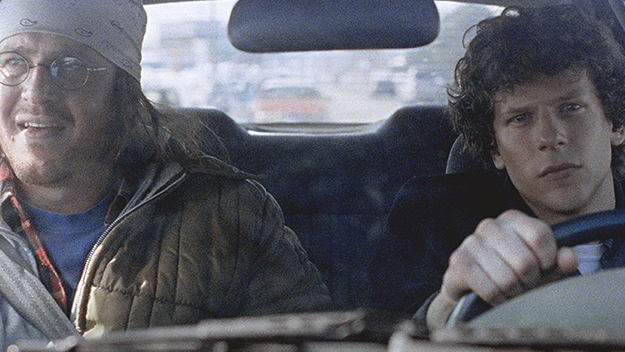
The question remains: is he willing to drill into the intellectual bedrock beneath the bonhomie? Or, as a fiction-writing rival, is he cruising Wallace for a journalistic bruising as he tools around with him? Eisenberg conveys the complications of being a cultural reporter on assignment, struggling to be emotionally present while figuring out when he’s gotten enough for his story or how much material he needs to finish it. What’s more important is that the actor displays a new transparency and poignancy as Lipsky sheds his own with-it persona.
Like a hipster version of a bromance, The End of the Tour wrings humor and pathos from a macho-intellectual pas de deux. But it ultimately taps a rare and delicate strain of fellow feeling. At the end, Wallace tells Lipsky, guy to guy, that it’s not so great to be him. And Lipsky pays Wallace the tribute of fully appreciating what it was like to be with him.
With an instinctive sense for the drama of quotidian motion, Ponsoldt’s camera keeps pace with Lipsky’s prowling and jabbing. But it also stops on a dime when any movement would be superfluous. Ponsoldt is a master of capturing images that are all the more emotional for being hazy, like Lipsky’s first view of Wallace surrounded by snow in front of his house, or their climactic soul-to-soul communion on a frozen field in blinding sunlight.
After the closing credits start to roll, Ponsoldt inserts a bit of business straight from Lipsky’s book: Wallace sits alone in his kitchen with Lipsky’s tape recorder while the reporter goes to the bathroom. “Now it’s just me and the tape recorder sittin’ here,” Wallace semi-croons. “Drone’s lookin’ at the floor, I’m smokin’. Having said I wasn’t going to smoke, I’m smoking. I’m just talking to your tape recorder.” It’s the only time in the movie that Wallace says something Lipsky can’t pick up on his own.
It’s like a benign version of the final act in HBO’s The Jinx. You feel the way Lipsky must have felt when he found it on his tape. You think: “Boy—am I happy to hear this guy again.”



